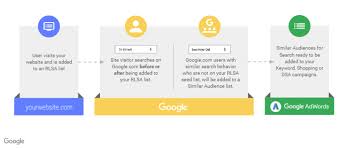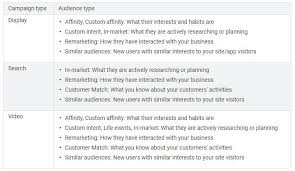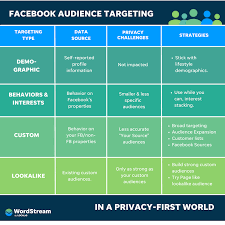Mastering Audience Targeting with Google Ads: A Guide to Precision Advertising
Effective Audience Targeting with Google Ads
In the world of digital advertising, reaching the right audience is crucial for the success of any campaign. With Google Ads, businesses have a powerful tool at their disposal to target specific audiences and maximise their advertising ROI.
One of the key benefits of using Google Ads is the ability to target audiences based on various factors such as demographics, interests, behaviours, and more. By utilising this targeting capability effectively, businesses can ensure that their ads are shown to users who are most likely to be interested in their products or services.
Demographic targeting allows advertisers to reach users based on factors such as age, gender, income level, and parental status. This helps businesses tailor their ads to specific demographic groups and increase the relevance of their messaging.
Interest targeting enables businesses to target users who have shown an interest in specific topics or products related to their offerings. By targeting users with relevant interests, businesses can increase the chances of driving engagement and conversions.
Behavioural targeting allows advertisers to reach users based on their online behaviour, such as websites they have visited or actions they have taken online. This type of targeting helps businesses connect with users who are actively researching products or services similar to theirs.
With Google Ads’ audience targeting capabilities, businesses can create highly targeted campaigns that deliver relevant ads to the right people at the right time. By reaching a more qualified audience, businesses can improve their click-through rates, conversion rates, and overall campaign performance.
In conclusion, effective audience targeting with Google Ads is essential for maximising the impact of your advertising efforts. By leveraging the platform’s advanced targeting options, businesses can reach the most relevant audiences and drive better results for their campaigns.
Top 5 Advantages of Audience Targeting in Google Ads: Enhancing Reach and ROI
- 1. Reach specific demographics
- 2. Increase relevance
- 3. Drive engagement
- 4. Improve campaign performance
- 5. Maximise ROI
Balancing Act: Navigating Privacy Concerns, Ad Fatigue, and Limited Reach in Google Ads Audience Targeting
1. Reach specific demographics
One significant advantage of audience targeting in Google Ads is the ability to reach specific demographics with precision. By targeting users based on factors such as age, gender, income level, and parental status, businesses can tailor their advertising messages to resonate with their intended audience. This level of specificity ensures that ads are shown to users who are most likely to be interested in the products or services being promoted, leading to higher engagement and increased chances of conversion. This targeted approach not only enhances the relevance of the ads but also maximises the efficiency and effectiveness of the advertising campaign.
2. Increase relevance
By utilising audience targeting in Google Ads to increase relevance, businesses can tailor their ads to users with specific interests that are closely related to their products or services. This targeted approach ensures that the right message is delivered to the right audience, increasing the chances of capturing their attention and driving engagement. By aligning ad content with users’ interests, businesses can create a more personalised and compelling advertising experience, ultimately leading to higher click-through rates and improved conversion rates.
3. Drive engagement
By utilising the audience targeting feature in Google Ads, businesses can effectively drive engagement by connecting with users who have demonstrated online behaviours that indicate an interest in their products or services. This targeted approach allows businesses to reach users who are actively seeking information or solutions related to what they offer, increasing the likelihood of meaningful interactions and conversions. By delivering relevant ads to these interested users, businesses can foster engagement and build relationships with their target audience, ultimately leading to improved campaign performance and results.
4. Improve campaign performance
By utilising audience targeting in Google Ads, businesses can significantly enhance their campaign performance. By reaching a more qualified audience, companies can improve their click-through rates and conversions. This targeted approach ensures that ads are shown to users who are more likely to be interested in the products or services being offered, leading to higher engagement and increased chances of conversion. Ultimately, by focusing on reaching the right audience, businesses can maximise the effectiveness of their campaigns and achieve better results in terms of driving user actions and achieving marketing objectives.
5. Maximise ROI
By leveraging audience targeting in Google Ads, businesses have the opportunity to maximise their return on investment (ROI) by reaching the right audience. By focusing their advertising efforts on specific demographics, interests, and behaviours, businesses can increase the effectiveness of their campaigns and drive better results. This targeted approach ensures that ads are shown to users who are more likely to engage with them, ultimately leading to higher conversion rates and improved ROI for businesses investing in digital advertising through Google Ads.
Privacy concerns
Privacy concerns are a significant con associated with audience targeting in Google Ads. This advertising approach involves the collection and utilisation of user data for targeted advertising, which can raise concerns about privacy infringement among some users. The practice of tracking user behaviour and preferences to deliver personalised ads may be perceived as intrusive, leading to potential backlash from individuals who value their online privacy. As businesses navigate the landscape of digital advertising, it is crucial to address these privacy concerns and ensure transparency in data collection practices to maintain trust with users.
Ad fatigue
Ad fatigue is a significant con of audience targeting in Google Ads. When businesses over-target their audience, showing the same ads repeatedly to users, it can lead to ad fatigue. This repetitive exposure can cause users to become disengaged and even annoyed with the ads, resulting in a negative impact on ad performance and user experience. Ad fatigue diminishes the effectiveness of advertising campaigns as users may start ignoring or actively avoiding the ads, ultimately reducing click-through rates and conversions. It is essential for businesses to strike a balance in their audience targeting strategy to avoid ad fatigue and maintain engagement with their target audience.
Limited reach
One drawback of audience targeting in Google Ads is the limited reach it can impose on campaigns. By narrowing down the audience targeting parameters too much, businesses run the risk of missing out on reaching new audiences and expanding brand awareness. This limitation may hinder the potential for growth and outreach to untapped markets, ultimately restricting the overall effectiveness and reach of the advertising efforts. It’s crucial for businesses to strike a balance between targeted audience segments and broader reach to ensure a well-rounded advertising strategy that maximises exposure while still engaging with relevant audiences.






